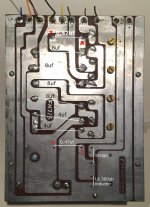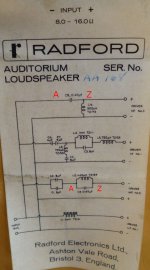Is there any impediment to placing speakers to close to each other?
There should be a benefit to placing the the mid and tweeters close together - less lobing?
So I bought the following replacement capacitors from willys-hifi.com for the Radfords I've rote earlier:
8x Mundorf ECap AC 8uf 70V Bipolar Electrolytic Capacitor - PLAIN
https://willys-hifi.com/products/mu...olytic-capacitor-plain?variant=42037499265279
4 x Mundorf ECap AC 4uf 70V Bipolar Electrolytic Capacitor - PLAIN
https://willys-hifi.com/products/mu...olytic-capacitor-plain?variant=42037209596159
4 x Mundorf MCap EVO Oil 0.47uf 450V Capacitor
https://willys-hifi.com/products/mundorf-mcap-evo-oil-0-47uf-450v-capacitor?variant=51344326867
I bought the more expensive 0.47uf "MCap EVO Oil" only because I couldn't find the cheaper "E Cap" at the 0.47uf rating.
Now I got a few questions regarding these capacitors:
1. I've measured all of them with the multimeter.
The 8uf Mundorf ECaps measure in the region of 9.2uf (+15%) rated +/-5%
The 4uf Mundorf ECaps read around 4.92uf (+23%) rated +/-5%
The 0.47uf Mundorf MCaps Evo Oil measured 0.465 (-1%) rated +/-3%
I wonder if it's normal for the ECaps to measure 15% - 20% higher out of the box given their +/-5% tolerance rating.
2. I was wondering if someone could have a look at the diagram and let me know if I got the A - Z ends of the Evo Oil caps right. Someone on a thread regarding capacitors Mundorf capacitors said "even though film caps are non polarized, the outside of the foil should be connected to the low Z side of the circuit."
Many thanks!
8x Mundorf ECap AC 8uf 70V Bipolar Electrolytic Capacitor - PLAIN
https://willys-hifi.com/products/mu...olytic-capacitor-plain?variant=42037499265279
4 x Mundorf ECap AC 4uf 70V Bipolar Electrolytic Capacitor - PLAIN
https://willys-hifi.com/products/mu...olytic-capacitor-plain?variant=42037209596159
4 x Mundorf MCap EVO Oil 0.47uf 450V Capacitor
https://willys-hifi.com/products/mundorf-mcap-evo-oil-0-47uf-450v-capacitor?variant=51344326867
I bought the more expensive 0.47uf "MCap EVO Oil" only because I couldn't find the cheaper "E Cap" at the 0.47uf rating.
Now I got a few questions regarding these capacitors:
1. I've measured all of them with the multimeter.
The 8uf Mundorf ECaps measure in the region of 9.2uf (+15%) rated +/-5%
The 4uf Mundorf ECaps read around 4.92uf (+23%) rated +/-5%
The 0.47uf Mundorf MCaps Evo Oil measured 0.465 (-1%) rated +/-3%
I wonder if it's normal for the ECaps to measure 15% - 20% higher out of the box given their +/-5% tolerance rating.
2. I was wondering if someone could have a look at the diagram and let me know if I got the A - Z ends of the Evo Oil caps right. Someone on a thread regarding capacitors Mundorf capacitors said "even though film caps are non polarized, the outside of the foil should be connected to the low Z side of the circuit."
Many thanks!
Attachments
Your multimeter will not measure capacitance as accurately as Mundorf who will use a more sophisticated and expensive LCR meter.
The measurement made by a low-cost multimeter may only be accurate for film capacitors.
I don't think you should be concerned about the orientation of the oil cap. I would regard the low Z side to be that nearest the amplifier terminals.
The measurement made by a low-cost multimeter may only be accurate for film capacitors.
I don't think you should be concerned about the orientation of the oil cap. I would regard the low Z side to be that nearest the amplifier terminals.
Thanks for the input Galu.Your multimeter will not measure capacitance as accurately as Mundorf who will use a more sophisticated and expensive LCR meter.
The measurement made by a low-cost multimeter may only be accurate for film capacitors.
I don't think you should be concerned about the orientation of the oil cap. I would regard the low Z side to be that nearest the amplifier terminals.
I'm a bit confused as from what I understood A would stand for the entrance of the power signal whereas Z would stand for the exit. Meaning A amp / binding posts and Z driver terminals.
Sorry, I'm a bit confused.
Also I didn't give it much thought but I'm assuming that the Mundorf ECaps are good enough for the job?!
Many thanks!
I meant that the low Z (impedance) side of the circuit would be that nearest to the amplifier terminals, i.e., to the speaker binding posts.
So, connect the outer foil at position A in your circuit diagram.
Don't sweat it as, in my opinion, the orientation of the oil capacitor will make no audible difference in a loudspeaker crossover.
The capacitor orientation is really only important in sensitive, small signal applications where the outer foil acts as a screen against
electric fields - which in the case of a valve amplifier coupling capacitor means connecting the outer foil to the anode of the previous stage.
The signals in a loudspeaker crossover circuit are much larger and so far less less susceptible to electric fields.
The Mundorf Ecaps are an excellent choice since, as the original capacitors are electrolytics, the Mundorfs will preserve the voicing of your speakers.
So, connect the outer foil at position A in your circuit diagram.
Don't sweat it as, in my opinion, the orientation of the oil capacitor will make no audible difference in a loudspeaker crossover.
The capacitor orientation is really only important in sensitive, small signal applications where the outer foil acts as a screen against
electric fields - which in the case of a valve amplifier coupling capacitor means connecting the outer foil to the anode of the previous stage.
The signals in a loudspeaker crossover circuit are much larger and so far less less susceptible to electric fields.
The Mundorf Ecaps are an excellent choice since, as the original capacitors are electrolytics, the Mundorfs will preserve the voicing of your speakers.
Last edited:
Great!I meant that the low Z (impedance) side of the circuit would be that nearest to the amplifier terminals, i.e., to the speaker binding posts.
So, connect the outer foil at position A in your circuit diagram.
Don't sweat it as, in my opinion, the orientation of the oil capacitor will make no audible difference in a loudspeaker crossover.
The capacitor orientation is really only important in sensitive, small signal applications where the outer foil acts as a screen against
electric fields - which in the case of a valve amplifier coupling capacitor means connecting the outer foil to the anode of the previous stage.
The signals in a loudspeaker crossover circuit are much larger and so far less less susceptible to electric fields.
The Mundorf Ecaps are an excellent choice since, as the original capacitors are electrolytics, the Mundorfs will preserve the voicing of your speakers.
I've soldered them as you've said outer foil pointing upstream away from the outputs.
More detailed info can be found in this video if anyone interested:
Many thanks!
SO glad you posted that, came up as first hit on “capacitor orientation” search on duckduckgo.
I was about to install some Mundorf Evo Supreme Ag/Au/oil and this answered a question I had about orientation.
Doing some tinkering (mostly stability, safety mods so far) on a Willsenton R8 tube amp, now doing the audio signal pathway updates.
I was about to install some Mundorf Evo Supreme Ag/Au/oil and this answered a question I had about orientation.
Doing some tinkering (mostly stability, safety mods so far) on a Willsenton R8 tube amp, now doing the audio signal pathway updates.
- Home
- Loudspeakers
- Multi-Way
- Anyone familiar with Radford speakers?

